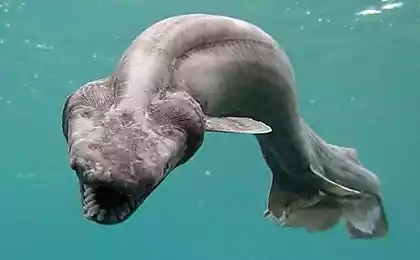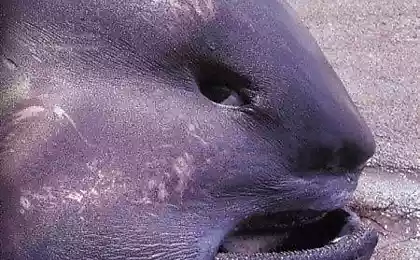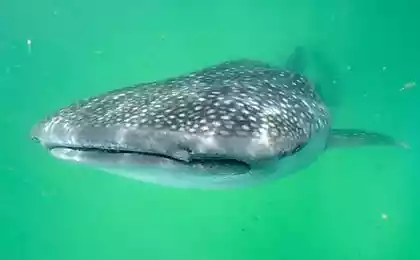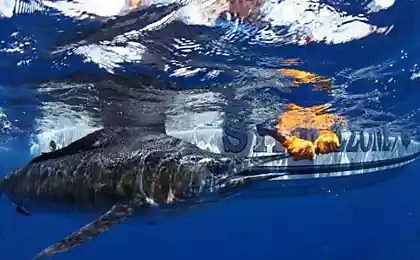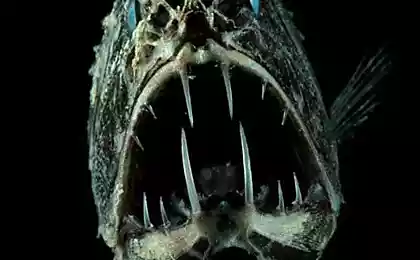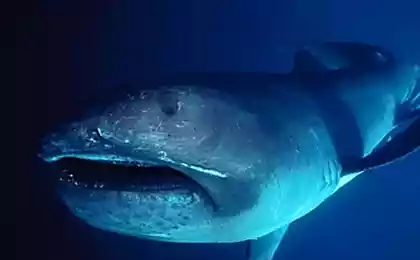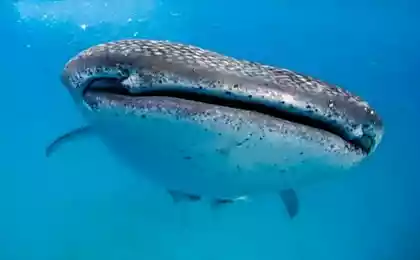208
Absolutely harmless to humans whale shark
Thor Heyerdahl called this fish a giant monster, so terrible that even a mystical sea snake could not frighten him more. A huge mouth, small evil eyes and a thick, powerful body can scare anyone. However, the whale shark (Latin Rhincodon typus) is completely harmless to humans. She feeds on plankton, paying no attention to the divers who try to ride on her back.
The whale shark is considered the largest of all known modern fish. The length of her body, according to various estimates, reaches 12-14, or even 18-20 meters. It is so unique that it is isolated in a separate family and a separate genus with a single species. But it has no subspecies: even those populations that live far apart and do not overlap have no genetic differences.
Whale shark prefers warm waters of low latitudes, where the surface water warms up to 21-26 degrees, and from the depth there is a cool tributary with a temperature of about 17 degrees. Most often it can be found off the coast of Taiwan and the Seychelles. Shark clusters are also observed off East and Southeast Africa, in the Gulf of Mexico, the waters of the Philippines and near the coast of Australia.
To meet a whale shark is a great luck. It was not very numerous before, and today it is a vulnerable species. The main threat is poaching, as in the countries of South and Southeast Asia its meat is eaten, despite the ban on catch. Getting such a huge and slow fish is easy: sometimes it is enough just to swim up to it and put a hook in the mouth, although fishermen use harpoon or nets much more often.
At the same time, natural growth is very slow, as whale sharks begin to breed at the age of 30 and sometimes 35 years, when their body length reaches 8-9 meters. This is an oviparous species, i.e. embryos hatch from capsule eggs directly inside the mother's womb. One female is able to produce from one to 10-15 babies about 60 cm long.
nationalgeographic.com
Little shark cubs can go without food for the first two weeks. They grow very quickly, sometimes by 1 cm per day. This is a kind of protective reaction, because larger sizes give more chances to survive in the ocean among predators. Young whale sharks are often attacked by blue sharks and killer whales, but adults have no enemies. Still: the thickness of their skin 10-14 cm - reliable protection from the teeth of any predator.
Whale sharks are extremely slow - under normal conditions, their speed rarely exceeds 5 km / h. During feeding, the fish can stop at all in one place, swaying smoothly up and down and moving its head from side to side. The shark eats everything it can swallow. Most often these are small crustaceans, jellyfish, squid, anchovies, sardines and other schooling fish, which it sucks together with water, and then filters, releasing water through the gill holes.
Whale sharks have several thousand teeth, but they are all small (up to 6 mm in length) and are needed not to bite prey, but to keep it in the mouth. From a huge jaw, expressed microorganisms through a narrow 10-centimeter esophagus enter the stomach. The shark eats long and long. Sometimes it takes up to 7.5 hours to feed, while in an hour it is able to swallow from one and a half to three kilograms of prey.
In the middle of the 19th century, the fame of the cannibal walked for the whale shark. Of course, that's far from the case. In fact, she is so kind and peaceful that she often even plays with swimmers. That's why divers love meeting her so much. Many tourists go to the Maldives, Seychelles or the Red Sea just to meet this unique fish.
Source: zoopicture.ru
The whale shark is considered the largest of all known modern fish. The length of her body, according to various estimates, reaches 12-14, or even 18-20 meters. It is so unique that it is isolated in a separate family and a separate genus with a single species. But it has no subspecies: even those populations that live far apart and do not overlap have no genetic differences.
Whale shark prefers warm waters of low latitudes, where the surface water warms up to 21-26 degrees, and from the depth there is a cool tributary with a temperature of about 17 degrees. Most often it can be found off the coast of Taiwan and the Seychelles. Shark clusters are also observed off East and Southeast Africa, in the Gulf of Mexico, the waters of the Philippines and near the coast of Australia.
To meet a whale shark is a great luck. It was not very numerous before, and today it is a vulnerable species. The main threat is poaching, as in the countries of South and Southeast Asia its meat is eaten, despite the ban on catch. Getting such a huge and slow fish is easy: sometimes it is enough just to swim up to it and put a hook in the mouth, although fishermen use harpoon or nets much more often.
At the same time, natural growth is very slow, as whale sharks begin to breed at the age of 30 and sometimes 35 years, when their body length reaches 8-9 meters. This is an oviparous species, i.e. embryos hatch from capsule eggs directly inside the mother's womb. One female is able to produce from one to 10-15 babies about 60 cm long.
nationalgeographic.com
Little shark cubs can go without food for the first two weeks. They grow very quickly, sometimes by 1 cm per day. This is a kind of protective reaction, because larger sizes give more chances to survive in the ocean among predators. Young whale sharks are often attacked by blue sharks and killer whales, but adults have no enemies. Still: the thickness of their skin 10-14 cm - reliable protection from the teeth of any predator.
Whale sharks are extremely slow - under normal conditions, their speed rarely exceeds 5 km / h. During feeding, the fish can stop at all in one place, swaying smoothly up and down and moving its head from side to side. The shark eats everything it can swallow. Most often these are small crustaceans, jellyfish, squid, anchovies, sardines and other schooling fish, which it sucks together with water, and then filters, releasing water through the gill holes.
Whale sharks have several thousand teeth, but they are all small (up to 6 mm in length) and are needed not to bite prey, but to keep it in the mouth. From a huge jaw, expressed microorganisms through a narrow 10-centimeter esophagus enter the stomach. The shark eats long and long. Sometimes it takes up to 7.5 hours to feed, while in an hour it is able to swallow from one and a half to three kilograms of prey.
In the middle of the 19th century, the fame of the cannibal walked for the whale shark. Of course, that's far from the case. In fact, she is so kind and peaceful that she often even plays with swimmers. That's why divers love meeting her so much. Many tourists go to the Maldives, Seychelles or the Red Sea just to meet this unique fish.
Source: zoopicture.ru
Car emissions kill more people than traffic accidents
Artificial pancreas can stop the diabetes epidemic
